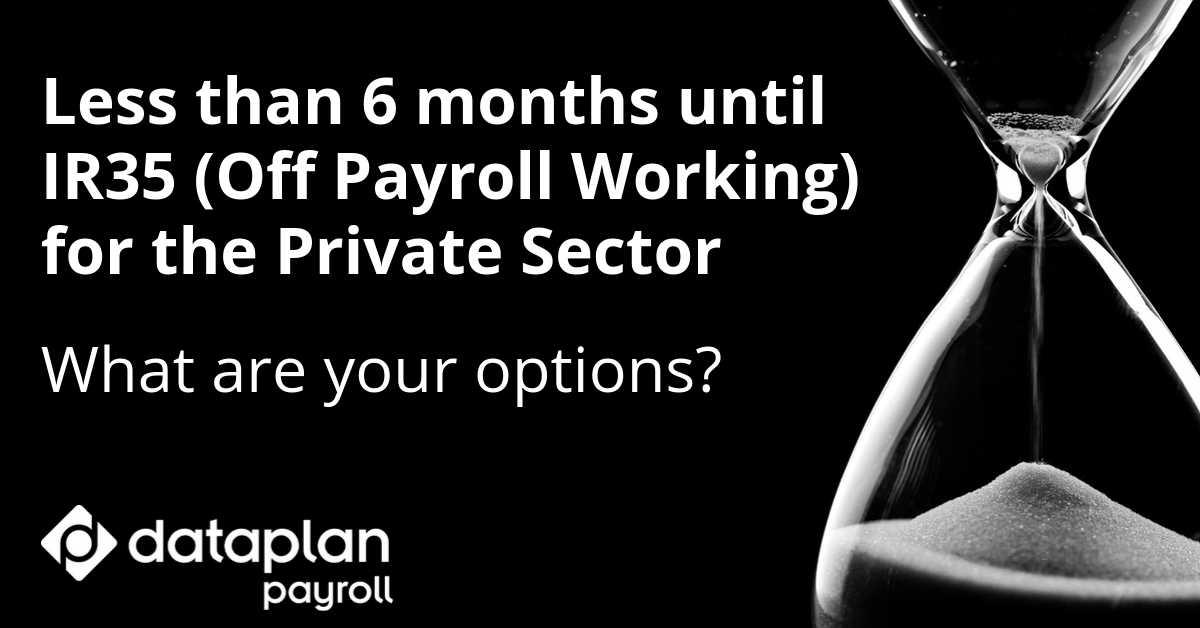
We are now less than 6 months away from the IR35 (Off Payroll Working) reforms hitting the private sector. Those of you in the public sector have had the privilege of having to assess employment status since 6 April 2017, now it is the private sectors turn.
There has been much publicity in recent days in the banking sector with first Barclays, and now Lloyds, stating that they will phase out the use of contractors in preparation for the change.
Don’t forget that from 6 April 2020, medium and large businesses will be responsible for assessing whether deemed employment applies for workers engaged through Personal Service Companies (PSC’s).
The purpose of this blog is to look at the various options available to the likes of Barclays and Lloyds and the larger clients we deal with here at Dataplan.
Option 1 – Do nothing
The old ‘stick your head in the sand’ approach will not work. HMRC have already commenced reviews of some NHS Trusts and if they find that workers engaged through PSC’s should have been employees, they will recover from the engager the PAYE, employee’s NIC and employer’s NIC that should have been paid over. Potentially very costly!
Option 2 – Assess each worker engaged through a PSC
Sounds obvious, but we hear stories all the time of companies either paying lip service to the IR35 reforms or thinking it does not affect them.
HMRC are due to release the upgrade Check Employment Status Tool (CEST) in December. I have been involved in the development of the tool in conjunction with HMRC and CIPP, it is a much improved tool and it should make the checking of employment status much easier.
A full assessment should therefore include every aspect of the work undertaken;
• Where it is undertaken
• What equipment is supplied and by whom
• What control the engager has over the worker and the work
• The terms for payment.
The list goes on. However early preparation is vital to enable the engager to plan for their own business in the future and advise the worker accordingly of the outcome of their review.
Option 3 – CEST says everything is okay, the worker can continue to operate through a PSC
This, naturally, is the best outcome for all concerned. However a word of caution; it must not be a contrived outcome just to make everybody’s life easier.
If, after undertaking a detailed review and using CEST, the status quo is maintained, engagers should retain a print out of the CEST result. This will be accepted by HMRC as evidence that the engager has undertaken due diligence and on the basis that the CSET has been used in good faith, HMRC will not overturn the judgement.
However if CEST has been completed incorrectly or the full information on the engagement not used, HMRC will overturn the decision and seek PAYE and NIC from the engager.
Option 4 – CEST deems the worker is caught by IR35
In simple terms, deemed employment is appropriate and the worker must be paid through the engagers PAYE system and tax and NIC accounted for. There are some exclusions from the operation of PAYE, for instance VAT (if the workers’ PSC is VAT registered).
Interestingly, when processing the payments through the payroll the tax code 0T must be applied and continue to be applied until and unless HMRC advises the engager to operate a revised tax code.
As with ‘normal’ employees, a P60 will be provided through the payroll at the tax year end.
Option 5 – Engaging workers (with their own PSC’s) through agencies
Many engagers may think that if the contract runs through an agency, they are not employing directly so do not need to worry about the new IR35 rules. Think again!
As the work is being done by the worker for the end client it is the responsibility for all links in the chain to undertake employment status checks, or at the very least, advise all other links in the chain that such checks have been undertaken and provide detailed evidence.
The end client should be insistent on such checks because, although they are not paying the worker directly, if an agency in the chain ceases to trade, or any other similar eventuality happens, the end client can be responsible for the operation of PAYE and therefore the payment to HMRC of PAYE and NIC deductions that should have been made.
Option 6 – The PSC operates through an Umbrella Company
Umbrella Companies are not ‘magic solutions’ to the IR35 conundrum. What they do provide is reduced paperwork and the possibility of reduced VAT through the VAT Flat Rate Scheme (I am not going into any detail on Flat Rate now as I haven’t the time or space!).
However an Umbrella Company should still operate PAYE and NIC on payments made to a director of their own PSC.
It is not surprising that large organisations are looking in detail now at contractors they are engaging, and in that case HMRC’s intention of moving such workers onto PAYE is certainly working. Historically, workers working through their own Limited Company have enjoyed significant tax breaks over workers they may be sat next to but are directly employed by the engager.
The reaction of the likes of Lloyds and Barclays may be extreme – moving all contractors to PAYE schemes, but what it does highlight is the need to act sooner than later for those businesses (over 250 employees) who the new legislation will apply to.
By moving contractors to a PAYE, the costs to the engager will increase as employers NIC will be payable at 13.8% and the worker pay will probably go down as the engager will reduce the equivalent hourly rate paid to the workers’ PSC to recover some or all of the employers NIC payable. So having the right solution based on a thorough review of employment status will make sure you are compliant and adopting the most tax efficient option.
I will be producing a monthly blog on IR35 in the run up to 6 April 2020 providing further guidance and advice so watch this space.
